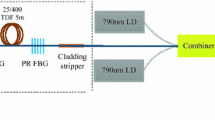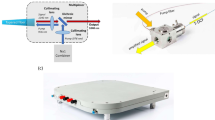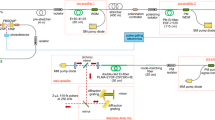Abstract
We report a high-efficiency, single-mode, all-fiber pulsed laser system built in a master oscillator power amplifier format, operating in the eye-safe (λ ~1,549 nm) spectral range, providing over 1.5 W of average output power with up to 51 dB of total signal gain. It comprises the flexibility of smooth pulse duration control from single ns to 260 ns with independently tunable repetition rate ranging from 40 kHz to 1 MHz. Pulses as short as 4 ns with up to 20 μJ energy and corresponding peak power of 5 kW are demonstrated. The laser system delivered a nearly diffraction-limited beam with M 2 ~1.
Similar content being viewed by others
Avoid common mistakes on your manuscript.
1 Introduction
Pulsed laser sources operating in the “eye-safe” (λ >1.4 µm) spectral range are desired for numerous applications, like remote sensing, range finding, material processing, area mapping, or mid-infrared super continuum generation [1–4]. Most of these applications require optical pulses of short duration, usually on the nanosecond-scale and with kW-level peak power. Pulses of such parameters can be easily obtained by Q-switching the optical cavity of both bulk [5, 6] and fiber [7] lasers. However, in case of all Q-switched lasers, the increase in repetition rate makes the output pulse duration increase (at constant pump power) and consequently, the pulse peak power decreases. This may be an obstacle for some applications, especially those where a high degree of pulse parameters control is needed. Therefore, a master oscillator power amplifier (MOPA) architecture [8] which utilizes a low-power pulsed seed laser followed by high-power amplification stages has been adopted. This technique is especially attractive if all system components, including a master oscillator and amplifiers, are developed in all-fiber technology, thus providing compactness, robustness, high environment insensitivity, and reliability.
Despite the fact that the first erbium-doped fiber amplifiers were demonstrated in the 80s of the twentieth century [9, 10], a still increasing interest in the development and optimization of these active devices has been observed. All-fiber pulsed MOPAs constitute one of the newest trends in optics and laser technology. A laser system developed in a MOPA configuration seeded with a single-mode semiconductor laser allows for a precise, electric control of temporal (pulse width, pulse shape, repetition rate) and spectral parameters in the wide range [11, 12], also providing a suitable gain for high-power operation. This unique flexibility makes high-power MOPA systems very attractive for many industrial and technological applications.
Generation possibility of high-energy, mJ pulses of eye-safe radiation from an all-fiber MOPA setup has been already demonstrated in [13]. However, the maximum achieved peak power, reported in this work, was below 2 kW due to the generation of long (hundreds nanoseconds) pulses and slope efficiency below 15 %. On the other hand, MW pulse peak power generation (1.4 mJ/1.2 MW) has been successfully demonstrated at 1,567 nm wavelength, but with poor beam quality (M2 ~ 8.5) and slope efficiency not exceeding 20 % [14].
In this paper, we present the results of two experiments where different ns-pulse operation regimes of 1,550 nm all-fiber laser system built in a MOPA configuration were discussed. Firstly, over 39 % of slope efficiency in a final power amplifier (which is, to the best of our knowledge, the highest efficiency for pulsed MOPA systems pumped at 980 nm that was ever reported) was reached during the generation of long (260 ns) pulses with energy ~30 µJ. And the total signal gain of over 51 dB and 5 kW peak power were presented for 4-ns pulse generation. The experimental system combines a broad range of pulse width (4–256 ns) and repetition rates (40 kHz–1 MHz) with high efficiency and nearly diffraction-limited laser beam.
2 Experimental setup
The arrangement of three-stage MOPA system is shown in Fig. 1. A distributed feedback (DFB) laser (QDFBLD-1550-50, QPhotonics), pigtailed in a polarization maintaining (PM) single-mode fiber, was used as a seed of nanosecond pulses generated at a variable pulse repetition frequency (PRF). The DFB laser was supplied by a homebuilt power supply with integrated pulse control system. The PRF of generated pulse train could be independently changeable in the range of 40 kHz–1 MHz.
The pulse train generated by the DFB laser was amplified in three amplifying stages, formed by two erbium preamplifiers (EDFAs) and a power erbium/ytterbium amplifier (EYDFA). Both EDFAs utilized heavily doped, single-mode, single-clad erbium-doped fibers (EDFs) with the core diameter of 8 µm and a numerical aperture NA = 0.2 (Liekki Er80-8/125). Low-power, single-stage fiber-optic isolators (>29 dB isolation), placed behind the seed and between the preamplifiers, were used to block any undesirable back-coming radiation. Three wavelength-stabilized, fiber-pigtailed laser diodes operating at 976 nm, each delivering up to 600 mW, were used to pump the EDFs. The single-mode pump radiation was launched into the active fibers with the use of 980/1,550 WDM couplers. A co-propagating, core pumping scheme incorporating a 1.3-m length of EDF was used in the first stage and a bidirectional pumping for 1.2 m EDF in the second stage.
The EYDFA was pumped with the use of a (2 × 1) + 1 multimode pump power combiner with a single-mode signal feed through at 1,550 nm. In the experiment, we utilized two different Er/Yb co-doped double-clad fibers. The first one was a single-mode fiber with a core/clad diameter of 7/125 μm and corresponding NAs of 0.21/0.46, whereas the other one was a slightly multimode fiber characterized by 13 μm/0.20 NA core and 130 μm/0.46 NA clad. Both were octagonal cladding fibers. The clad absorption at 915 nm was 1.1 and 2.84 dB/m for single-mode and multimode EYDFs, respectively. Up to 4 W of CW pump power at 973 nm, generated by a single fiber-coupled laser diode, was delivered to the final EYDFA.
In order to eliminate out of band amplified spontaneous emission (ASE), two 200 GHz DWDM (CH35) band-pass filters were fusion-spliced between the amplifying stages. So as to block any back reflections, each laser system stage was optically isolated. In addition, to monitor the spectrum and pulse parameters, two tap couplers were applied in the MOPA system: a 1 × 2 (99/1 %) coupler after the first amplifying stage and a 2 × 2 (99.99/0.01 %) coupler placed after the second preamplifier.
3 Results and discussion
The erbium preamplifiers provided 46 dB of total gain (for 5-ns pulses) of which up to 33 dB was obtained in the first stage. In the experiment, the output power levels of seed and preamplifiers were kept constant, whereas the pump power of the EYDFA was varied in the range from 0 to 4 W.
During the measurements, all output spectra were recorded using an optical spectrum analyzer (Yokogawa AQ6370B). Temporal trace was measured with the use of a sampling digital oscilloscope (Tektronix, DSA70604) with 6-GHz bandwidth, 25GS/s and InGaAs photodetector (with rise time of <125 ps), and the output average power was measured by a power meter (Ophir, Laserstar) with a thermal sensor.
3.1 High-efficiency operation
In preliminary experiments, a single-mode, double-clad Er/Yb co-doped fiber (CorActive 7/128) was used as a gain medium of the third amplifying stage. The appropriate active fiber length optimization allowed us to obtain a slope efficiency as high as 39 % for a 5-m-long EYDF. To the best of our knowledge, the reported maximum efficiency for 1.5-µm laser pumped at 980 nm is 43 % [15]. However, this result concerns the continuous-wave generation but our MOPA system operated in pulsed regime. The average output power and the EYDF absorption both determined with respect to launched pump power are presented in Fig. 2. All measurements have been taken when the laser system generated 260-ns pulses with 50-kHz repetition.
Along with the increase in active fiber length, the pump absorption increases from 63 to 87 % for 2- and 5-m-long EYDF, respectively. It corresponds to over 10 % increase in slope efficiency of 1.5-µm laser radiation generation from 29 to 39 %, determined with respect to incident pump power. This efficiency reaches, about 43 % when corresponding to absorbed pump power for 3- and 5-m-long EYDF and 44 % for the 2-m-long active fiber. As it can be seen in the inset in Fig. 2, further lengthening of the active fiber, over 5 m, does not cause any benefit, the output power begins to decrease due to the reabsorption process.
Although the relatively long active fiber provides high generation efficiency, the long interaction length of guided waves in the fiber resulted in the enhancement of nonlinear effects leading to output spectrum broadening (Fig. 3). Since the length of fiber used in the EYDFA construction is much shorter than the dispersion length L D and longer than the nonlinear length L NL (L D ≫ L > L NL ), the dispersion effect can be ignored [16]. The spectrum broadening was induced by the self-phase modulation. Furthermore, for the 3-m-long EYDF, the effect of degenerated four-wave mixing (DFWM)—two spectral sidebands located symmetrically by about ±19 nm from the signal at 1,549 nm—can be distinguished in the spectrum presented in Fig. 3. Two photons of signal at frequency corresponding to 1,549 nm create two different photons at the probe frequency ω 1 and idler frequency 2ω 0− ω 1 . The longer fiber length, the higher nonlinear phase shift is, and consequently, further spectrum broadening is observed, which limits the generation of high peak power laser pulses.
As it can be seen, increasing the fiber length to 5 m leads to super continuum generation with over 150 nm span measured within −50 dB below the maximum peak at 1.55 µm. This shows that when developing a pulsed fiber MOPA system, we have to be aware of the fact that further fiber lengthening or increase in pulse peak power will significantly enhance nonlinear processes leading to much broader continuum generation.
3.2 High peak power operation
Construction of fiber lasers and amplifiers provides a relatively long interaction length for guided radiation, which combined with high intensity of light propagating in a small area core can lead to strong nonlinear effects, thus limiting their lasing or amplification possibilities. The main challenge in case of high-power pulsed fiber-based laser sources delivering short pulses is to overcome the undesirable nonlinear phenomena, like stimulated Brillouin scattering (SBS) and Raman scattering (SRS), self-phase modulation (SPM). Reducing optical intensities, due to utilizing fibers with large core, e.g., large mode area (LMA) fibers, is one of the methods used for overcoming the nonlinearities and producing high output energy and high peak power [17, 18]. Another method for reducing the nonlinearities is fiber shortening.
In our experiment, both methods have been applied. In the third cascade, instead of the single-mode fiber (CorActive 7/128), we utilized 2-m-long multimode Er/Yb co-doped, double-clad fiber (Nufern 12/130). The performance of the developed amplifier is illustrated in Fig. 4, where average output power as a function of launched pump power is depicted. The normalized frequency—V number of the active fiber—equals 4.87 at 1,549 nm corresponding to <10 propagating modes. This approach enabled for the generation of stable 5-kW peak power laser pulses (Fig. 5) at 40-kHz repetition rate. The output pulse is characterized by an asymmetric shape, and it is a ~1 ns shorter than input pulse. This small pulse distortion is the consequence of the population inversion change during an amplification process when a laser pulse with energy comparable with the saturation energy of amplifying medium is launched into the amplifier. The leading edge of the pulse depletes the most population inversion, thus experiencing higher gain than the trailing pulse edge. For pulses generated with higher repetition frequency, no difference between the input and the output pulse shapes has been observed. The performance of the developed MOPA is illustrated in Fig. 6, where the peak and average output power as a function of pulse repetition frequency are depicted. For pulses generated at repetition rate higher than 80 kHz, the MOPA system was operated in the saturation. Pulse peak power decreases with frequency but the average output power remains constant at 830 mW power level. Frequency tuning from 40 kHz to 1 MHz made pulsed energy decrease from over 20 µJ to slightly below 1 µJ, corresponding to the decrease in peak power from 5 kW to hundreds of watts (~170 W). Our main goal was to reach a compromise between the high peak power and high-efficiency generation with relatively narrow output spectrum. Therefore, in this experiment, we did not reduce the active fiber length below 2 m and the pump power was kept constant and equalled 2.62 W. For the 5-kW pulse generation, the signal-to-noise ratio S/N was over 30 dB.
In order to provide high quality of output laser beam (single-mode operation) and to remove unabsorbed pump power radiation, we searched for a simple and cost-effective solution. The reduction in unabsorbed pump power, which is usually present at the output of amplifier pumped in co-propagating scheme, can be conventionally achieved by applying a power cladding striper providing about 10–15 dB of clad power attenuation. Adding this fiber component to the laser system output leads, besides additional costs, to lengthening the interaction fiber length and as a consequence to decreasing the threshold of nonlinear effects occurrence. Therefore, in order to provide high-quality output laser beam, single-mode operation, and remove unabsorbed pump power radiation, we spliced 20 cm of standard telecom SMF-28e with FC/APC connector to the end of active multimode Er/Yb-doped fiber. It introduced 0.7 dB loss at 1.5 μm signal wavelength for 1 W of average output power and made 5 % decrease in slope efficiency (Fig. 4). This approach allowed us to suppress the unabsorbed pump power at the system output (Fig. 7) as well as to achieve an excellent spatial properties of the beam, which is nearly diffraction-limited with M2 < 1.03 (Fig. 8). The measurement of beam diameter has been taken at the 1/e2 intensity level with the use of scanning slit beam profiler (BP109-IR Thorlabs). It can be also noted that a very high signal-to-noise ratio S/N >58 dB was obtained in the output spectrum without any ASE at ~1 μm wavelength range. Besides, we also proved experimentally that this approach can be successfully adopted for low and medium output power levels (unabsorbed pump power level <1 W). The system was tested for a few weeks, and during this time, we did not notice any failure or degradation of output parameters.
The described system was packed in the 134.5 mm × 261 mm x 300 mm rugged metal case. All optical components and electronics were included in the package for a standalone unit requiring only power supply. Since the laser output is delivered via a single-mode optical fiber with FC/APC connector, it can be easily linked with a collimator, which provides easy integration with a variety of other systems.
4 Conclusions
An all-fiber, three-stage MOPA system operating at 1.55 μm is presented. A record slope efficiency of 44 % determined with respect to absorbed pump power of the final power EYDFA pumped at 980 nm is reported incorporating a single-mode double-clad Er/Yb co-doped fiber. Furthermore, we show that applying a multimode Er/Yb co-doped fiber followed by a standard SMF-28e can be a simple and cost-effective method to eliminate unabsorbed pump radiation from the signal beam and to provide single-mode operation. Generation of 5-kW pulses at 40-kHz repetition rate from a compact, standalone laser unit was also presented.
The performance of the single-mode all-fiber laser system in combination with high peak power shows that our three-stage MOPA setup can be very suitable source of “eye-safe” laser radiation for a variety of applications, including laser rangefinders, range imaging LADAR systems, and remote sensing LIDAR applications or even mid-infrared super continuum generation.
References
P. Wan, J. Liu, L. Yang, F. Amzajerdian, Proc. SPIE 7817, 78170K (2010)
J. Henrie, M.S. Bowers, R. Afzal, B. Jenson, Proc. SPIE 6952, 695204 (2008)
E. Bayaki, D.S. Michalopoulos, R. Schober, IEEE Trans. Commun. 60(12), 3797 (2012)
J. Swiderski, M. Michalska, Opt. Laser Technol. 52, 75 (2013)
L. Gorajek, J.K. Jabczynski, W. Zendzian, J. Kwiatkowski, H. Jelinkova, J. Sulc, M. Nemec, Opt Electron Rev 17, 309 (2009)
L. Galecki, M. Eichhorn, W. Zendzian, Laser Phys. Lett. 10, 105813 (2013)
J. Wang, S. Cui, L. Si, J. Chen, Y. Feng, Opt. Express 21, 289 (2013)
J. Swiderski, M. Maciejewska, W. Pichola, J. Kwiatkowski, M. Mamajek, Proc. SPIE 8433, 84331E (2012)
R.J. Mears, L. Reekie, M. Jauncey, D.N. Payne, Electron. Lett. 26, 1026 (1987)
R.I. Laming, M.C. Farries, P.R. Morkel, L. Reekie, D.N. Payne, P.L. Scrivener, F. Fontana, A. Righetti, Electron. Lett. 25, 12 (1989)
D. Mao, X. Liu, L. Wang, H. Lu, H. Feng, Opt. Express 18, 23024 (2010)
C. Gao, S. Zhu, W. Zhao, Z. Cao, Z. Yang, Chin. Opt. Lett. 7, 611 (2009)
V. Philippov, J.K. Sahu, C. Codemard, W.A. Clarkson, J.N. Jang, J. Nilsson, G.N. Pearson, Proc. SPIE 5335, 1 (2004)
S. Desmoulins, F. Di Teodoro, Opt. Express 16, 2431 (2008)
D.Y. Shen, J.K. Sahu, W.A. Clarkson, Opt. Express 13, 4916 (2005)
G.P. Agrawal, Nonlinear fiber optics, 4th edn. (Academic Press, San Diego, 2007)
X. Peng, K. Kim et al., Opt. Express 21, 32411 (2013)
J.C. Jasapara, M.J. Andrejco, A.D. Yablon, J.W. Nicholson, C. Headley, D. DiGiovanni, Opt. Lett. 32, 2429 (2007)
Acknowledgments
This research has been partially supported by the Foundation for Polish Science under Ventures Programme, co-financed from the European Union, Regional Development Fund. The splicing optimization procedure was performed thanks to the support from the Polish National Center under Project No. DEC-2011/01/N/ST8/04109.
Author information
Authors and Affiliations
Corresponding author
Rights and permissions
Open Access This article is distributed under the terms of the Creative Commons Attribution License which permits any use, distribution, and reproduction in any medium, provided the original author(s) and the source are credited.
About this article
Cite this article
Michalska, M., Swiderski, J. Highly efficient, kW peak power, 1.55 µm all-fiber MOPA system with a diffraction-limited laser output beam. Appl. Phys. B 117, 841–846 (2014). https://doi.org/10.1007/s00340-014-5895-x
Received:
Accepted:
Published:
Issue Date:
DOI: https://doi.org/10.1007/s00340-014-5895-x












